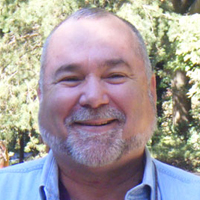
It has been a pleasure for me to support some of the bright minds at NATO ACT (Atlantic Command Transformation, the old SACLANT), and it has also incentivized me to familiarize myself with where NATO is today and where it might go in the future.[1] As one who has decades of experience with the US system that absolutely does not want to change, I have a healthy respect for the ability of the NATO bureaucracy in Europe to drown out any common sense that may come its way from the NATO bureaucracy in the USA, so I thought to have a go at making a case to NATO directly and SOCOM indirectly for coming together with the other regional and type theater commanders to ask of the Secretary of Defense an Open Source Agency (OSA) and all that can offer, including a Multinational Decision Support Centre on the shores of the Mediterranean focused on Africa, the Caucasus, and Central Asia, with a second in Tampa focused on the Americas and everywhere else.
NATO 4.0: Key Challenges AND Solutions
Mindful of all that has already been said or written on this topic – including the implementation concepts of Smart Defense and Connected Forces and the issues of the day (cyber-security and missile defense)[2] – I humbly submit that NATO has yet to address the substance of what Admiral James Stavrides calls “Open Source Security.” [3] NATO can strengthen partnerships globally by achieving intelligence with integrity. NATO, in alliance with USSOCOM, can claim pre-approved money (IOC 125M FOC 2B) for an Open Source Agency (OSA).
In my view, the three challenges that must be addressed with a transformation mind-set are:
01 DESIGN: Learn how to say “no” to the Americans, “yes” to the EU, and “let’s talk” to everyone else. This requires a transformation of how NATO thinks of itself, how it organizes, and how it makes decisions.
02 MONEY: Integrate at the staff level with the EU and become the hub for any other combination of nations so as to use intelligence (decision-support) to both spend smarter, and harmonize resources globally.
03 EFFECT: Create a technical and human factors model attractive to the BRICS and the regional associations, one that can be used to substitute local to global informed consensus for violence, wealth, time, and space.
CHALLENGE #1: DESIGN
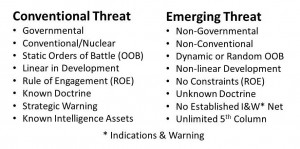
NATO’s first challenge is its legacy and its lack of agility in transforming itself. I wrote the first article – in 1989 – making it clear that in the 21st Century “defense” was going to be about emerging non-traditional threats that required a completely different approach to defense including intelligence and whole of government operations. [4] I embrace Admiral James Stavrides’ parting words as confirmation of my vision and of the relevance of this essay to NATO now.
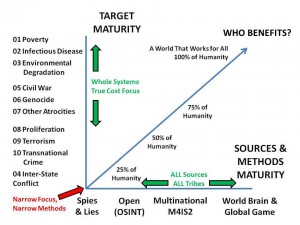
Still addressing the first challenge, this graphic, in “The Evolving Craft of Intelligence,”[5] leverages the findings of the UN High-Level Panel on Threats, Challenges, and Change, A More Secure World: Our Shared Responsibility (2004). Although systems dynamics has been understood by academics and engineers for decades, governments have refused to embrace holistic thinking for the simple reason that war is more profitable for banks than is peace. Peaceful preventive measures cost a fraction of remediation with violence. This was the point General Gray agreed to make in 1989, but no one wanted to listen because war is too profitable for the few while the profits of peace are so widely distributed as to be of little interest to the craven and the criminal. Given the lack of funds, now is the time to take all this seriously. NATO has a good structure as a base for a global capability, but creating a new division is not a sufficient adaptation.[6]
It is vital in my view, that the US give up control precisely to free NATO to integrate with the EU, create a model attractive to the BRICS, and transform into something vastly more useful to the US and everyone else – a global network for multinational information-sharing and sense-making that does not exist today, and that will never be contemplated by the United Nations because “intelligence” is anathema there, as well as a threat to its varied rice bowls.
CHALLENGE #2: MONEY
I created the budget for the Open Source Agency (OSA) and the embedded Multinational Decision-Support Centre. These are NATO’s for the asking, with the recommendation that the US Special Operations Command and the US regional theater commanders be invited to collaborate in a group approach to the Secretary of Defense.
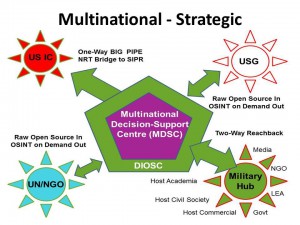
In the USA, 30% to 50% of every dollar is waste. This has been documented across many functions, including agriculture, defense, energy, and health. European countries have similar inefficiencies, in part because no one does true cost full life cycle economics, and all relevant information never comes together in one time and place for effect. The EU and NATO have an opportunity to create the world’s first multinational decision-support centre, and to do so in a manner that begins to immediately influence both how the EU spends money, and how others spend money—around the globe across all threats, within all policy domains, harmonized country by country, regional issue by regional issue.
Where all countries and all international organizations all short – and the primary reason for both the incoherence of the United Nations and the ineffectiveness of all foreign aid be it private or public – is in failing to establish the facts or what the military likes to call “ground truth.” Too often aid – and intervention – are driven by ideological or financial objectives that fail to calculate – more often than not deliberately – the true cost to the public and to others of any given course of action.
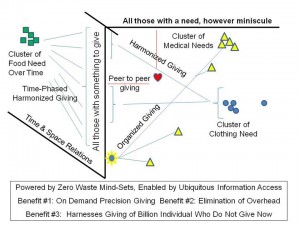
Western defense and western capitalism are rooted in the needs of the one billion rich, and mis-directed by the excessive influence of the banks and the inadequacy of government intelligence. The 21st Century is about meeting the needs of the five billion poor, and empowering them so that they can create infinite wealth. What this really means is that the BRICS – plus Indonesia – own the future. NATO ACT’s Innovation Hub has developed the concept of Alternative C2 (AltC2) – I helped – and it is a real alternative to NATO’s legacy C4ISR. It is the only affordable, inherently interoperable, and thus globally scalable means of interacting with all others.
The time has come for an organization such as NATO, integrated at the staff level with the EU, to be able to develop a comprehensive cultural, historical, and linguistic understanding of any given topic, and to recommend precision remediation, best done as a peaceful preventive measure than as a violent regime change.
CHALLENGE #3: EFFECT
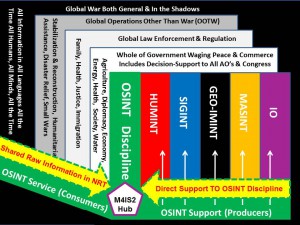
NATO needs its own organic intelligence capabilities, and it must be able to inspire trust while fully integrating its planning, programming, budgeting, and operational command and control capabilities with those of the EU as well as other ad hoc partners in any given coalition. The solution to both being more relevant and capable, and mastering the three challenges, is to lead the way in Open Source Everything (OSE, the technical solution), and Multinational, Multiagency, Multidisciplinary, Multidomain Information-Sharing and Sense-Making (M4IS2, the human solution).
I am quite certain that if the military commander of SHAPE and NATO were to come together with the military commander of the US Special Operations Command (USSOCOM), they can gain the necessary approval for becoming joint executive agents for the OSA, which has an embedded Multinational Decision Support Centre in its pre-approved concept, as well as a diplomatic Office of Information-Sharing Treaties and Agreements.
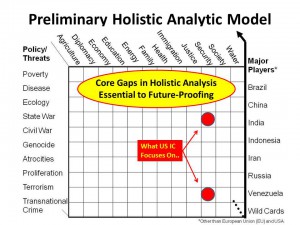
Creating a new mind-set requires a strategic analytic model that is holistic; a decision-support methodology that respects true cost economics; and a commitment to transparency and the complete integration of non-military and military capabilities on a foundation of shared information and shared sense-making. Burden-sharing over the long-term demands coherence – holistic intelligence with integrity that drives education & training, exercises and operations, and the use of all technologies with common standards and certification and reductions of export controls, emphasizing open source.
If we ae to help the BRICS and Indonesia avoid our mistakes, we must transform ourselves. What we have been doing is not working, will not work, and cannot be fixed. It must be replaced by transformation.
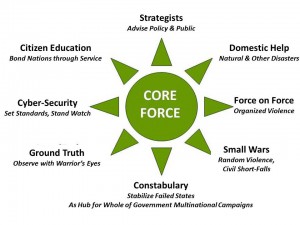
For NATO to become the “core force” and end its isolation from the EU while increasing its utility to all nation-states including the BRICS, I believe further discussion is needed and that NATO must plan for capabilities in eight core areas, some of them non-traditional. The greatest challenge is the first challenge – if the Secretary General and the new military commander can embrace a new mind-set that positions NATO — and SOCOM — and the other theater commanders — and Whole of Government — as I have suggested above, then I have no doubt that within 2-5 years NATO will have transformed itself into the “hub” of a global security network without peer. Prove the OSA model with EU and AU, then extend it to the BRICS+.
I and a handful of others have been working on the concept of an Open Source Agency, and the logical associated ideas of a World Brain and a Global Game, the latter played by everyone with a hand-held device and enabling voice and vote by all on any issue in real time. The US bureaucracy – disturbingly similar to the NATO bureaucracy – has refused to heal itself, and in so doing, demonstrated the need for an extra-national network that can enable ethical evidence-based decision-support through multinational information-sharing and sense-making that is transparent and truthful, and therefore inspiring of trust and because of trust, sustainable. I know how to do this. St.
About the Author
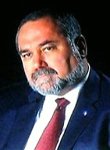
Robert David STEELE Vivas (legal name STEELE, Vivas is the Latino matronymic) is the CEO pro bono of Earth Intelligence Network, a 501c3 he personally funded in 2006 to create a strategic analytic model and an architecture for the World Brain and Global Game. Previously he served as CEO of Open Source Solutions Network, Inc., a one-man C Corporation with global reach that pioneered Open Source Intelligence (OSINT) globally, including NATO and SOCOM. He served for 18 years in the US Government, as a Marine Corps officer (S-1/Adjutant, Infantry, International Relations, Intelligence), as a clandestine operations officer for the Central Intelligence Agency who also did counterintelligence and advanced information and satellite technology programs, and as the second ranking civilian in Marine Corps intelligence and co-creator of the Marine Corps Intelligence Activity. Since leaving government in 1993 he has been a vocal critic of secrecy and torture and more recently of indiscriminate assassination by drone. Widely published including pieces in French and Spanish, he is in passing the #1 Amazon reviewer for non-fiction, reading in 98 categories. He is actively seeking employment and is globally mobile, fluent in Spanish, with elementary to intermediate French. His motto in the pursuit of public intelligence in the public interest is “the truth at any cost lowers all other costs.” See Also: Who’s Who in Collective, Earth, Peace, & Public Intelligence: Robert David STEELE Vivas
Endnotes:
1. The four pieces are clearly identified within NATO OSINT to OSE/M4IS2 Round-Up 2.0, two on Alternative C2 and two on Human Factors. See also 21st Century Public Intelligence 3.7. I am adding over time, to the Round-Up, a selection of NATO documents and links, “NATO In Its Own Words.”
2. Cf. Ambassador Alexander Vershbow, NATO DSG, “Challenges facing NATO and the Transatlantic Community post-2014,” 30th International Workshop on Global Security (Paris, France, 24 June 2013), See also Qwant / NATO Transformation.
3. I discuss his concept and provide references in my “Foreword” to E. Mordini and M. Green (eds.), Internet-Based Intelligence in Public Health Emergencies (IOS Press, NATO Science for Peace and Security Series, 2013).
4. Cf. General Al Gray, USMC (Commandant), “Global Intelligence Challenges in the 1990’s,” American Intelligence Journal (Winter 1989-1990). I was his ghost-writer at the time, and also the second-ranking civilian in Marine Corps Intelligence.
5. In Robert Dover, Michael Goodman, and Claudia Hillebrand (eds.). Routledge Companion to Intelligence Studies (Oxford, UK: Routledge, 22 August 2013).
6. Senior leaders who wish to understand the difference between reformation and transformation, between doing the wrong thing righter or the right thing, will find this post helpful: Reference: Russell Ackoff on Doing Right Things Righter.
Post-Publication Commentaries
Neal Rauhauser: Steele on NATO, AIPAC Replaces US IC — Steele Comments



